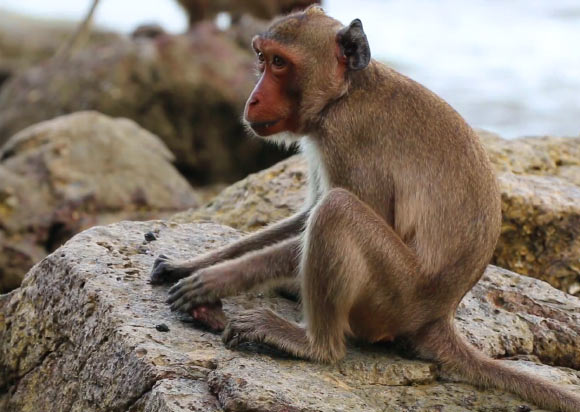Long-tailed macaques (Macaca fascicularis aurea) on Piak Nam Yai, one of Thailand’s coastal islands, have been using stone tools for several decades — and possibly thousands of years — to eat shellfish and nuts, according to a study led by Dr. Michael Haslam from the University of Oxford, UK.
“We find that primates with much smaller brains than humans have innovative ways of exploiting the food sources available to them,” Dr. Haslam said.
“Macaques in the forests on the island come down to the shore when the tide is out to forage, and use stones as tools in order to break open shells and hard nut casings to access the food inside.”
From a distance in boats off the coast, Dr. Haslam and his colleagues spent hundreds of hours watching how groups of long-tailed macaques on the small island of Piak Nam Yai, in Laem Son National Park, selected stones as tools to crush marine snails, nuts and crabs.
While the tide was out, the macaques broke open oysters attached to large boulders. They dislodged the top half of the shell using their crushing tool and then scooped out the meat with their fingers from the remaining part still attached to the rock.
The researchers also found that once a macaque had a good stone fit for the job, they would keep it to crack open other shells or nuts before dropping it.
On average the primates ate nine oysters at a time, moving short distances (up to 290 feet, or 90 m) with the same tool. However, in one case the team observed a hungry macaque eat 63 oysters in a row, using the same stone tool to cleave the shells open.
Once the job was done, the macaques often discarded their tools around the same boulders where they had enjoyed their meal.
When the animals had left the shore, the scientists went on land to closely examine the tools for marks.
They found features such as pitting on the flat side, or crushing and fracture marks on the narrow ends of the stones.
They also excavated the area beneath a prominent boulder for evidence of discarded stone tools used by previous generations of macaques.
Having identified the tell-tale marks of food processing, the team spotted ten tools in the oldest archaeological layer, at 2.1 feet (65 cm) below the surface.
The researchers were limited in how far down they could dig given the high tides that inundated the boulder twice a day.
They indirectly dated the excavated tools as between 10 and 50 years old, through obtaining radiocarbon dates for oyster shell debris found in the same undisturbed archaeological layer.
The findings were published online May 30 in the Journal of Human Evolution.
According to the team, this is the first report into the archaeological evidence of tool use by Old World monkeys.
“What we don’t have at the moment is a body of archaeological evidence to compare the evolutionary behavior of other primates with our own,” Dr. Haslam said.
“Uncovering the history of the macaques’ foraging behavior is a first step.”
“As we build up a fuller picture of their evolutionary history, we will start to identify the similarities and differences in human behavior and that of other primates.”
_____
Michael Haslam et al. Archaeological excavation of wild macaque stone tools. Journal of Human Evolution, published online May 30, 2016; doi: 10.1016/j.jhevol.2016.05.002








